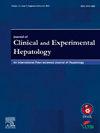复杂肝细胞癌亚型的处理:弥漫性浸润、大肿瘤和肿瘤破裂——挑战和策略
IF 3.3
Q2 GASTROENTEROLOGY & HEPATOLOGY
Journal of Clinical and Experimental Hepatology
Pub Date : 2025-01-22
DOI:10.1016/j.jceh.2025.102505
引用次数: 0
摘要
肝细胞癌(HCC)是全球第六大常见癌症原因,癌症相关死亡的第三大常见原因,也是最常见的原发性肝脏恶性肿瘤。虽然明确的结节性HCC仍然是典型的表型,但浸润性表型、非常大的HCC以及肿瘤破裂等并发症为诊断和治疗带来了巨大的挑战。浸润性肝细胞癌很难与背景性肝硬化区分。它们在影像学上定义不清,血管性差,生物行为具有攻击性。血管侵袭、转移以及对局部、区域和全身治疗的不良反应导致预后不佳。与浸润性HCC相比,超大型HCC的预后相对较好,因此需要采用多模式治疗,以达到包括肝移植在内的治疗反应。介入放射学技术的改进,包括免疫疗法在内的系统性治疗的新证据,以及对肿瘤生物学的更好理解,为此类复杂病例的管理开辟了新的途径。肝细胞癌破裂是肝细胞癌自然史上的一个灾难性时刻,其死亡率呈指数增长。临床表现为腹痛、低血压/晕厥、新发或腹水突然增加,强烈怀疑腹水破裂。诊断性腹膜充血和计算机断层扫描/磁共振成像造影剂外渗是诊断标志。紧急手术干预、温和栓塞形式的局部治疗或化疗栓塞是治疗的基石。长期生存和肝移植作为一种治愈性治疗仍然需要更多的数据,因为担心肿瘤扩散是可能的。这篇综述总结了这一进展的HCC的临床挑战,并提供了一种治疗的算法方法。本文章由计算机程序翻译,如有差异,请以英文原文为准。

Managing Complex Hepatocellular Carcinoma Subtypes: Diffuse Infiltrative, Large Tumours, and Tumour Rupture—The Challenges and Strategies
Hepatocellular carcinoma (HCC) is the sixth most common cause of cancer globally, third most common cause of cancer-related death, and most common primary liver malignancy. Whilst nodular well-defined HCC remains the classical phenotype, presentations with infiltrative phenotype, very large HCC, and complications as tumour rupture provide immense diagnostic and therapeutic challenges. Infiltrative HCC is difficult to distinguish against the background cirrhotic liver. They are ill defined on imaging, have poor vascularity, and aggressive biological behaviour. Vascular invasion, metastasis, and poor response to loco-regional, as well as systemic therapy, leads to dismal prognosis. Very large HCCs have a relatively better prognosis than infiltrative HCC and mandate multimodal therapies to downstage for a curative response including liver transplant. Improvement in interventional radiology techniques, emerging evidence with systemic therapies including immunotherapy, and better understanding of tumour biology have opened newer avenues in the management of such complex cases. HCC rupture is a catastrophic moment in the natural history of HCC which has an exponential increase in mortality. Clinical presentation of pain abdomen, hypotension/syncope, new onset, or sudden increase in ascites mandates a strong suspicion of rupture. Presence of hemoperitoneum on diagnostic tap and contrast extravasation in a computed tomography/magnetic resonance imaging are the diagnostic hallmarks. Emergency surgical intervention, locoregional therapies in the form of bland embolisation, or chemoembolisation forms the management cornerstone. The long-term survival and liver transplant as a curative therapy still needs more data as fear of tumour spread is a possibility. This review summarises the clinical challenges with this advance HCC and provides an algorithmic approach for management.
求助全文
通过发布文献求助,成功后即可免费获取论文全文。
去求助
来源期刊

Journal of Clinical and Experimental Hepatology
GASTROENTEROLOGY & HEPATOLOGY-
CiteScore
4.90
自引率
16.70%
发文量
537
审稿时长
64 days
 求助内容:
求助内容: 应助结果提醒方式:
应助结果提醒方式:


